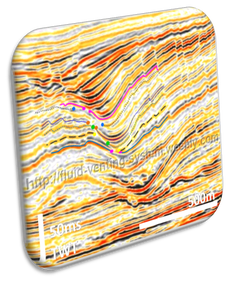New types of pockmarks
Key words: Sutieng Ho pockmark
Pockmarks are conical geological structures induced by brutal fluid expulsion on the seafloor (Judd and Hovland, 2007). They occur in fine grained marine sediments (Hovland and Judd, 1988) and in general exhibit circular to sub-circular plan forms.
Pockmarks have been firstly discovered by King and MacLean (1970) on seismic profiles on the Scotian Shelf (Hovland et al., 1984). Since the thirty years, pockmarks have been extensively studied and are widely recognized as indicator of fluid leakage (cf. Josenhans et al., 1978, Gay et al., 2006).
A classification of pockmarks has been established by Hovland et al. (2002), but since the imaging quality of acquired seismic data has been improved in the last two decades, pockmarks with more complex internal structures have been revealed by high resolution seismic and thus more new types of pockmarks have been discovered.
In this section, new types of pockmarks in Offshore Angola and in North West Shelf Australia are documented.
Please click on the titles below to link to the pages.
|
Polyphased pockmarks, Offshore Angola _ |
Conference presentations on the collapsed-pockmarks
Seismic 'Stylolites'
- Imbert & Ho (2012)
Collapsed funnels offshore Australia: Evidence for past hydrate pockmarks?
- Imbert, Ho, Cauquil (2012)
- Imbert, Ho, Cauquil (2012)
Key words: Sutieng Ho pockmark Sutieng Ho gas chimney seismic Sutieng Ho polygonal fault Sutieng Ho methane authigenic carbonate Sutieng Ho Lower Congo Basin Angola




